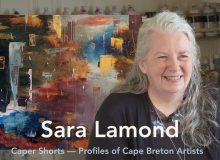En Plein Air Painting: a quick guide to getting started this summer
The mornings have even more light now that it is summer. From the warm yellow brightness coming through my bedroom curtains, I can feel that it is going to be a beautiful day, a vibrant day full of promise. A good day to start painting en plein air which means getting outside and making art. It can become a passion.
Many famous artists at some time worked en plein air, most notably the Impressionists who were fascinated with the depiction of ever-changing light. Van Gogh, a post-Impressionist or Expressionist, added an intense layer of emotion to his paintings done en plein air, conveying the excitement and near-ecstasy of immersing himself in nature in order to create. I get that. It is vastly different from working from the flatness of a photo. Visceral is how I would describe it. It combines quiet observation, awareness, appreciation for the natural world and creativity.

Pondville Beach on Isle Madame has some delightful nooks and crannies to paint, plus it has some spots to get in out of that early cool Cape Breton breeze coming off the water. You need to get things down on paper quickly before the light or the weather changes, so you learn to express yourself with an economy of technique and not get hung up on perfection. Spontaneous and intuitive, capturing the moment is more like it. There can also be a bit of physical activity built in. Climb over that rock to get a better view or hike down that woodsy path to see what’s around the bend.

Simple materials can suffice
Simple materials can suffice. I have several en plein air kits assembled in various old leather purses found at thrift stores. The simplest smallest one has a miniature pad, graphite and other pencils, eraser and a sharpener. It’s just for sketching and can be tucked in anywhere. In my more elaborate kit I’ve added coloured pencils, more types of drawing pencils, watercolour pencils and two different size larger pads. This one stays in the car and when my husband and I go exploring or find a nice spot to sip our to-go coffee, I can draw if I want to.

This year I’m adding a viewfinder to help me find and frame my subjects. Some might include a small colour wheel. Oh, and don’t forget a folding lawn chair or camp stool to sit on and a good hat. Sunscreen or bug spray can also come in handy.
Materials could be as simple as a pad of newsprint and a pencil. I like to go for materials with a bit more quality because it does affect the finished product and ease of use. For watercolours, Sakura Koi has two very suitable watercolour field kits – one with 30 colours for around $40 and one with 12 for around $20. De Serres has a very reasonably priced watercolour travel box with 12 colours, a water bottle, 1 fineliner, 1 reservoir brush, 1 HB pencil and 1 sponge.

When choosing a watercolour paper, I prefer the heavier, 300 gram cold pressed, because it does not have to be stretched and is suited for a variety of techniques. For a looser watercolour style, rough paper is a good choice and can create interesting effects because of its pitted texture. Top quality archival paper is made from cotton but there are many good papers made from wood pulp for beginners and amateurs.
As for brushes, a mid-priced array of round brushes in various sizes is recommended. Just make sure there is one brush for fine detail. I also really like using Chinese brushes. Their tapered shape allows for a variety of brushstroke thicknesses and, for the money and durability, I consider them a bargain. I carry three sizes of them with me. But we’re getting into a whole other post here. So right now, just ask yourself these three questions: Is it a nice day to be outside? Are your drawing or painting materials packed and ready to go? Where will you wander to make art?

Plein air Trivia
-
Origin of the Term: The term “plein air” is derived from the French phrase “en plein air,” which means “in the open air.” It refers to the act of painting outdoors, capturing natural light and scenery.
-
Impressionist Movement: Plein air painting became particularly popular during the Impressionist movement in the late 19th century. Artists like Claude Monet, Pierre-Auguste Renoir, and Camille Pissarro were well-known for their outdoor works.
-
Portable Paint Tubes: The invention of portable paint tubes in the mid-19th century by John Goffe Rand revolutionized plein air painting. Before this, artists had to mix and store their own paints, making outdoor painting cumbersome.
-
Barbizon School: The Barbizon School of painters in France, active from around 1830 to 1870, was one of the first groups to emphasize painting outdoors. They influenced the later Impressionist movement.
-
Plein Air Competitions: Many regions around the world host plein air painting competitions and festivals. These events gather artists to paint local landscapes and often include exhibitions and awards for the best works.
Don't settle for the cliche view. Turn around.








